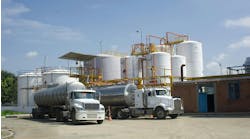Lytx's 2023 State of the Data Report contained some fascinating information. Of course, as a fuel efficiency guy, the details on idling are what I found most interesting. Here's what Lytx found:
- Vehicles spent less time idling in 2022 compared to 2021
- Idle times for Lytx clients dropped about 16%
- More than 90 million tons of CO2 emissions were saved from less idling
- More than $24 million in wasted fuel was prevented.
The timing of the release of the report could not have been better. Summer is when trucks can spend a lot of time idling to run air conditioning to keep drivers cool. We all want drivers to be cool and comfortable so they can get a good night's rest and be alert the next day.
The good news is that there are many options for keeping the cab cool that don't involve idling and some best practices that can help keep the truck cool without the need to idle.
We shared some passive idle reduction options in the North American Council for Freight Efficiency Confidence Report on Idle-Reduction Technologies. These include adding insulation, using curtains, light-colored paint, and other simple tips such as parking in the shade, avoiding parking on blacktop in the summer, and pre-cooling the cab before shutting the main engine down. Electrotonic engine parameters can also be set to limit idling.
See also: Veteran drivers teach how to reach 10 MPG
Our report also covered add-on devices that fleets could invest in to reduce idling. There are a variety of options for fleets to select from. One of the key conclusions in the report was that the most efficient and effective idle-reduction solution for a fleet would entail a combination of complementary technologies. We identified four anchor technologies that can serve as the basis for idle reduction solutions recognizing that drivers idle trucks in hot and cold weather.
We learned in the report that there is no "one size fits all" solution to idle reduction. Many technologies are available, but each has pros and cons that need to be evaluated, and many can be combined to help reduce idling. Every fleet has different goals. Therefore, each technology's benefits, costs, benefits, and challenges need to be weighed along with overall fleet objectives.
And, of course, you must remember that the driver is the most important part of successfully managing idle times. Ensure drivers are informed about your idle-reduction goals and know how to operate any idle-reduction devices you have installed on your trucks.
The goal is to keep drivers safe and comfortable during the dog days of summer while at the same time reducing idle time and emissions from idling.
This summer, let's ensure drivers stay safe and cool on the roads while idling less.
Michael Roeth has worked in the commercial vehicle industry for nearly 30 years, most recently as executive director of the North American Council for Freight Efficiency (NACFE). He serves on the second National Academy of Sciences Committee on Technologies and Approaches for Reducing the Fuel Consumption of Medium and Heavy-Duty Vehicles and has held various positions in engineering, quality, sales, and plant management with Navistar and Behr/Cummins.




